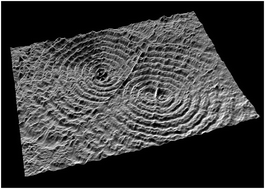Self-organized spatio-temporal micropatterning in ferromagnetic Co–In films†
Abstract
Cobalt–indium (Co–In) heterogeneous films, featuring spatio-temporal patterns, have been electrodeposited in a chloride–citrate electrolyte. The Co content can be tuned from 25 at% to 90 at% by varying the applied current density between −10 and −30 mA cm−2. The spatio-temporal patterns consist of alternated dark and bright belts, which define micron-sized waves, targets and spirals. Cross-sectional images indicate layer-by-layer growth. Several crystallographic phases (hexagonal close-packed Co, face-centered cubic Co, tetragonal In and tetragonal CoIn3) are identified in the corresponding X-ray diffractograms. The films exhibit a combination of large hardness with relatively large Young's modulus and a soft-magnetic behaviour with tunable saturation magnetisation and coercivity (HC) values, mostly depending on the Co content and the effective magnetic anisotropy. The film with 90 at% Co shows the highest in-plane HC (275 Oe) and a squareness ratio close to 1. Magnetic force microscopy observations reveal that the self-patterning is not only topographic but also magnetic. These results demonstrate that the electrodeposition of spatio-temporal structures is a simple method to grow magnetically patterned films, over large areas, in a rapid and inexpensive way. This procedure is highly attractive for the implementation of new types of magnetic sensors, encoding magnetic stripes or even magnetic recording media.


 Please wait while we load your content...
Please wait while we load your content...